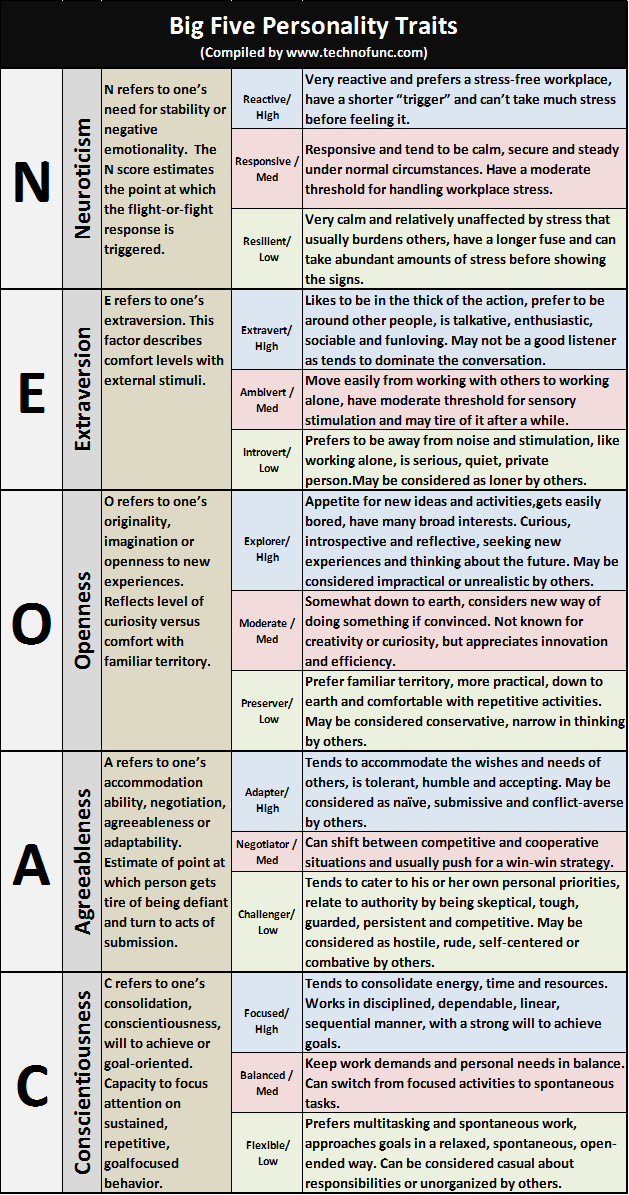- Home
- Business Processes
- Industry Knowledge
- Aerospace Industry
- Automotive Industry
- Banking Domain
- BFSI Industry
- Consumer/ FMCG Industry
- Chemicals Industry
- Engineering & Construction
- Energy Industry
- Education Domain
- Finance Domain
- Hospitality Domain
- Healthcare Industry
- Insurance Domain
- Retail Industry
- Travel and Tourism Domain
- Telecom Industry
- Leadership Skills
- eLearning
- Home
- Leadership
- Leadership Theories
- Five-Factor Personality Model
Five-Factor Personality Model
Five Factors Model (FFM) also known as Five-Factor Personality Model is based on five broad personality traits which are extraversion, neuroticism, openness to experience, agreeableness, and conscientiousness represented by acronym OCEAN, these traits are often referred to as the “Big Five”.
What are Big Five Personality Traits:
Over the past 25 years, a consensus has emerged among researchers regarding the basic factors that make up what we call personality. Psychologists now believe that of all the various methods for classifying personality dimensions, only one stands out as the most statistically robust: the Big Five. These factors, commonly called the Big Five, are neuroticism, extraversion, openness, agreeableness and conscientiousness.
N = Neuroticism = Need for stability, negative emotionality
E = Extraversion = Positive emotionality, sociability
O = Openness = Originality, imagination
A = Agreeableness = Accommodation, adaptability
C = Conscientiousness = Consolidation, will to achieve, goal-oriented
Table below provides the description, attributes and explanations for each of the factors listed above. These five personality factors are the most reliable for differentiating personality traits. The Big Five synonym clusters appear to account for most differences among individual personalities, describing five universal dimensions. We score a high, low or mid-range rating in each dimension and interpretations of the scores is given below:
|
Big Five Personality Traits |
||||
|
N |
Neuroticism |
N refers to one’s need for stability or negative emotionality. The N score estimates the point at which the flight-or-fight response is triggered. |
|
Very reactive and prefers a stress-free workplace, have a shorter “trigger” and can’t take much stress before feeling it. |
|
Responsive / |
Responsive and tend to be calm, secure and steady under normal circumstances. Have a moderate threshold for handling workplace stress. |
|||
|
Resilient/ |
Very calm and relatively unaffected by stress that usually burdens others, have a longer fuse and can take abundant amounts of stress before showing the signs. |
|||
|
E |
Extraversion |
E refers to one’s extraversion. This factor describes comfort levels with external stimuli. |
|
Likes to be in the thick of the action, prefer to be around other people, is talkative, enthusiastic, sociable and funloving. May not be a good listener as tends to dominate the conversation. |
|
Ambivert / |
Move easily from working with others to working alone, have moderate threshold for sensory stimulation and may tire of it after a while. |
|||
|
Introvert/ |
Prefers to be away from noise and stimulation, like working alone, is serious, quiet, private person.May be considered as loner by others. |
|||
|
O |
Openness |
O refers to one’s originality, imagination or openness to new experiences. Reflects level of curiosity versus comfort with familiar territory. |
|
Appetite for new ideas and activities,gets easily bored, have many broad interests. Curious, introspective and reflective, seeking new experiences and thinking about the future. May be considered impractical or unrealistic by others. |
|
Moderate / |
Somewhat down to earth, considers new way of doing something if convinced. Not known for creativity or curiosity, but appreciates innovation and efficiency. |
|||
|
Preserver/ |
Prefer familiar territory, more practical, down to earth and comfortable with repetitive activities. May be considered conservative, narrow in thinking by others. |
|||
|
A |
Agreeableness |
A refers to one’s accommodation ability, negotiation, agreeableness or adaptability. Estimate of point at which person gets tire of being defiant and turn to acts of submission. |
|
Tends to accommodate the wishes and needs of others, is tolerant, humble and accepting. May be considered as naïve, submissive and conflict-averse by others. |
|
Negotiator / |
Can shift between competitive and cooperative situations and usually push for a win-win strategy. |
|||
|
Challenger/ |
Tends to cater to his or her own personal priorities, relate to authority by being skeptical, tough, guarded, persistent and competitive. May be considered as hostile, rude, self-centered or combative by others. |
|||
|
C |
Conscientiousness |
C refers to one’s consolidation, conscientiousness, will to achieve or goal-oriented. Capacity to focus attention on sustained, repetitive, goalfocused behavior. |
|
Tends to consolidate energy, time and resources. Works in disciplined, dependable, linear, sequential manner, with a strong will to achieve goals. |
|
Balanced / |
Keep work demands and personal needs in balance. Can switch from focused activities to spontaneous tasks. |
|||
|
Flexible/ |
Prefers multitasking and spontaneous work, approaches goals in a relaxed, spontaneous, open-ended way. Can be considered casual about responsibilities or unorganized by others. |
|||
Study to Examine Big Five Personality Dimensions:
To assess the links between the Big Five and leadership, Judge, Bono, Ilies, and Gerhardt (2002) conducted a major meta-analysis of 78 leadership and personality studies and found a strong relationship between the Big Five traits and leadership.
This model of leadership was result of a study to examine the relationship between the “Big Five” personality dimensions (neuroticism, conscientiousness, extraversion, agreeableness, and openness) with respect to career success. A sample of few hundred employees was surveyed in a diverse set of occupations and organizations. Hierarchical regression analysis was used to examine the incremental variance contributed by the five personality traits after controlling for several career-related variables.
Results showed that, extraversion was related positively to salary level, promotions, and career satisfaction and that neuroticism was related negatively to career satisfaction. Agreeableness was related negatively only to career satisfaction and openness was related negatively to salary level. It was confirmed as expected that having certain personality traits is associated with being an effective leader.
Is the Big Five personality assessment valid?
Researchers have pointed to reliability studies that are consistent enough to approach the status of law and for the corporate world; this model provides a reliable, standard vocabulary with which to discuss personality differences. Although the Big Five model gives us a uniform language based on standard definitions, but the fact remains that a combination of forces shape an individual. The Five Factors can be thought as being the main infrastructure as human individuality is too complex for any one system to explain adequately.
This personality assessment can be practically applied to identify the needs of a specific role prior to selecting or appointing a leader and performing a match of factors to determine success of the individual in the role.

Related Links
You May Also Like
-
McClelland's Theory of Needs is a human motivation theory which states that an individual's specific needs are acquired over time through our culture and life experiences. As per the three needs theory, these acquired needs significantly influence the behavior of an individual. The three main driving motivators are the needs for achievement, affiliation, and power.
-
Five Factors Model (FFM) also known as Five-Factor Personality Model is based on five broad personality traits which are extraversion, neuroticism, openness to experience, agreeableness, and conscientiousness represented by acronym OCEAN, these traits are often referred to as the “Big Five”.
-
Burns Transformational Leadership Theory
Transformational leadership theory has been defined by James MacGregor Burns as a process where both leaders and followers mutually raise one another to higher levels of morality and motivation. The concept of transforming leader works with teams to garner trust, respect, and admiration while reaching to higher moral positions. The transformational theory of leadership was developed while studying political leaders and how they use charismatic methods to attract people to the values.
-
Bass's Transformational Leadership Theory
Bass Transformational Leadership Theory is based on performance beyond expectations approach which defines four elements of transformational leadership. The 4 elements described by Bernard A. Bass in 1985 are Idealised Influence, Intellectual Stimulation, Individualised Consideration, and Inspirational Motivation. This study highlights four key insights about performance beyond expectations and associated criteria to measure it.
-
Strategic Contingencies Theory is a theory of intra-organizational power. The power of a subunit or individual depends on a few contingencies and that the more contingencies are controlled by a subunit, the greater is its power. The theory focuses on tasks that need to be done in the form of problems to be solved, thus de-emphasizing personality.
-
The Valence Model of Leadership
The valence model of emergent leadership is based on a group-development sequence. As per the valence model, the process of emergent leadership passes through three distinct stages; Orientation, Conflict, and Emergence. Group members willingly start following and obeying the leader who has passed the "emergence threshold."
-
Transformational Theories of Leadership
Transformational leadership theories focus on the leadership approach where the leader encourages, inspires employees to innovate and create positive and valuable organizational change. A transformational leader works towards “transforming” the culture to one that cultivates trust, mutual admiration, loyalty, and respect with the end goal of developing followers into leaders. Transformational leaders are known to be visionary, inspiring, daring, risk-takers, and thoughtful.
-
The group and exchange theories of leadership are derived from social psychology. These have their roots in the exchange theory. Leaders from different kinds of relationships with various groups of subordinates. Group theories describe how leaders need to maintain their position in group dynamics.
-
Lewin’s Change Management Model
Lewin's change management model is a framework for managing organizational change. Lewin's methodology of different Leadership Styles recognizes three distinct stages of change - creating the perception; moving toward the new desired level of behavior and, ensuring new behavior as the norm.
-
Leader-Participation Model provides a set of rules to determine the form and amount of participative decision making. It helps identifies different ways a decision can be made based on the degree of follower participation. It proposes a method for leaders to involve all members of the organization work together to make decisions.
Explore Our Free Training Articles or
Sign Up to Start With Our eLearning Courses

About Us
Learning
© 2023 TechnoFunc, All Rights Reserved










